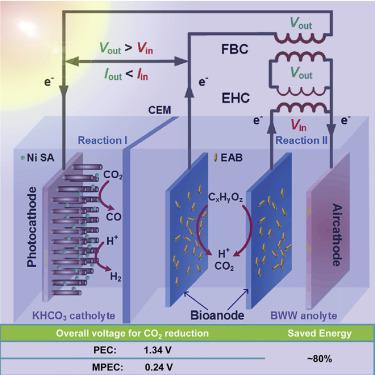Joule ( IF 38.6 ) Pub Date : 2020-09-21 , DOI: 10.1016/j.joule.2020.08.014 Lu Lu , Zhida Li , Xi Chen , Huan Wang , Sheng Dai , Xiaoqing Pan , Zhiyong Jason Ren , Jing Gu

|
The photoelectrochemical (PEC) reduction of CO2 to syngas is an attractive strategy for solar-to-fuel conversion. However, the high overpotential, inadequate selectivity, and high cost demand for alternative solutions. Here, we demonstrate a hybrid microbial photoelectrochemical (MPEC) system that contains a microbial anode capable of oxidizing waste organics in wastewater and reducing the oxidation potential by 1.1 V compared with abiotic water oxidation using a PEC anode. Moreover, the MPEC employs a power management circuit (PMC) to enable parallel low-energy-producing reactions operated in the same solution medium to conquer high-overpotential reactions. The nanowire silicon photocathode integrated with a selective single-atom nickel catalyst (Si NW/Ni SA) achieved up to ∼80% faradic efficiency for CO generation with a highly tunable CO:H2 generation ratio (0.1 to 6.8). When the bioanode was coupled with the Si NW/Ni SA, up to 1.1 mA cm−2 of spontaneous photocurrent density was obtained for high-rate syngas generation.
中文翻译:

能源有利的废水微生物阳极驱动的CO 2自发生产太阳能合成气
光电化学(PEC)还原CO 2合成气是太阳能转化燃料的一种有吸引力的策略。然而,对替代解决方案的高过电位,选择性不足和高成本需求。在这里,我们展示了一种混合微生物光电化学(MPEC)系统,该系统包含一个微生物阳极,与使用PEC阳极的非生物水氧化法相比,该阳极能够氧化废水中的废有机物并将氧化电势降低1.1V。此外,MPEC使用电源管理电路(PMC)来使在同一溶液介质中进行的并行产生低能量的反应能够克服高电势反应。集成有选择性单原子镍催化剂(Si NW / Ni SA)的纳米线硅光电阴极可通过高度可调的CO:H 2达到高达80%的法拉第效率以产生CO。生成比例(0.1到6.8)。当将生物阳极与Si NW / Ni SA耦合时,可获得高达1.1 mA cm -2的自发光电流密度,可实现高速率合成气的产生。











































 京公网安备 11010802027423号
京公网安备 11010802027423号